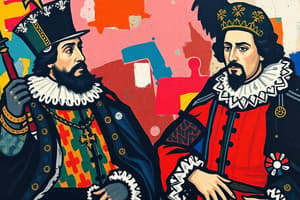Podcast
Questions and Answers
What major political structure was established after the reign of Oliver Cromwell?
What major political structure was established after the reign of Oliver Cromwell?
- A theocracy
- A dictatorship
- A constitutional monarchy (correct)
- A military junta
What significant action did Charles I take in 1629 that escalated tensions with Parliament?
What significant action did Charles I take in 1629 that escalated tensions with Parliament?
- He imposed heavy taxation without Parliament's consent (correct)
- He executed leading Puritan leaders
- He declared war on Scotland
- He disbanded the Anglican Church
Who succeeded Oliver Cromwell as Lord Protector of the Realm?
Who succeeded Oliver Cromwell as Lord Protector of the Realm?
- Richard Cromwell (correct)
- Charles II
- James II
- Charles I
Which of the following best describes the relationship between Charles I and Parliament during his reign?
Which of the following best describes the relationship between Charles I and Parliament during his reign?
What was Oliver Cromwell's army known for during the English Civil War?
What was Oliver Cromwell's army known for during the English Civil War?
Flashcards
Constitutional Monarchy
Constitutional Monarchy
A form of government where the monarch's power is limited by a constitution, typically a parliament.
Charles I's Dissolution of Parliament
Charles I's Dissolution of Parliament
In 1629, Charles I dissolved Parliament and began ruling without its consent, imposing taxes on his own authority, creating a huge conflict with the Parliament.
Richard Cromwell
Richard Cromwell
Oliver Cromwell's son, Richard, briefly succeeded him as Lord Protector after Cromwell's death in 1658.
English Civil War
English Civil War
Signup and view all the flashcards
Parliamentarian Victory at Naseby
Parliamentarian Victory at Naseby
Signup and view all the flashcards
Study Notes
Stuart Kings and the Restoration Period
- The Stuart Kings' reign initiated in 1603 with James VI of Scotland, who became James I of England and Ireland.
- The Restoration refers to the period when Charles II regained the throne after a 20-year Commonwealth led by Oliver Cromwell.
Key Events and Figures
- Charles I ruled from 1625 to 1649 and was known for his oppressive policies, even more so than his father James I.
- He dissolved Parliament in 1629 and attempted to impose heavy taxation, which sparked unrest among the Puritans.
- Notable tensions emerged as a result of Charles I's Catholic tendencies, alienating Puritans who sought religious reform.
The English Civil War
- The conflict ignited in 1642 between Royalists (supporters of the King) and Puritans, leading to a civil war.
- The Puritans rejected the Anglican Church for not going far enough in reforms aimed at Christianity.
Outcome of the Civil War
- In 1645, Oliver Cromwell's army defeated King Charles I.
- King Charles I was executed in 1649 after a trial, marking a significant moment in British history.
Cromwell's Leadership
- After the execution, Cromwell took on the role of leader of the Council of State and became the Lord Protector of the Realm.
Transition to Monarchy
- Cromwell died in 1658, and his son Richard briefly succeeded him, but the country fell into political confusion.
- This unstable environment paved the way for the monarchy's return in 1660 when Charles II returned from exile in France.
- Charles II accepted the principle of constitutional monarchy, restoring royal authority within a framework of law.
Studying That Suits You
Use AI to generate personalized quizzes and flashcards to suit your learning preferences.




